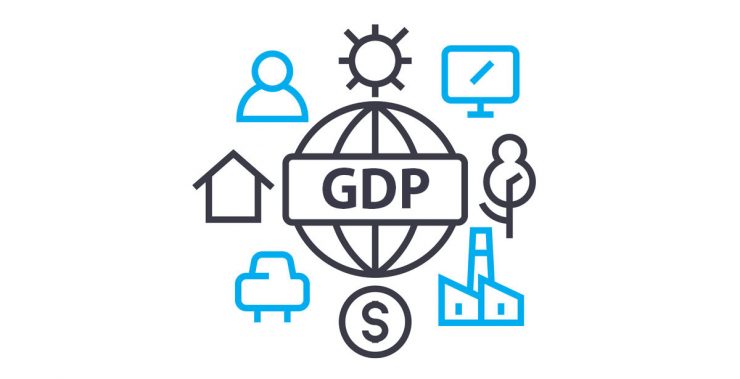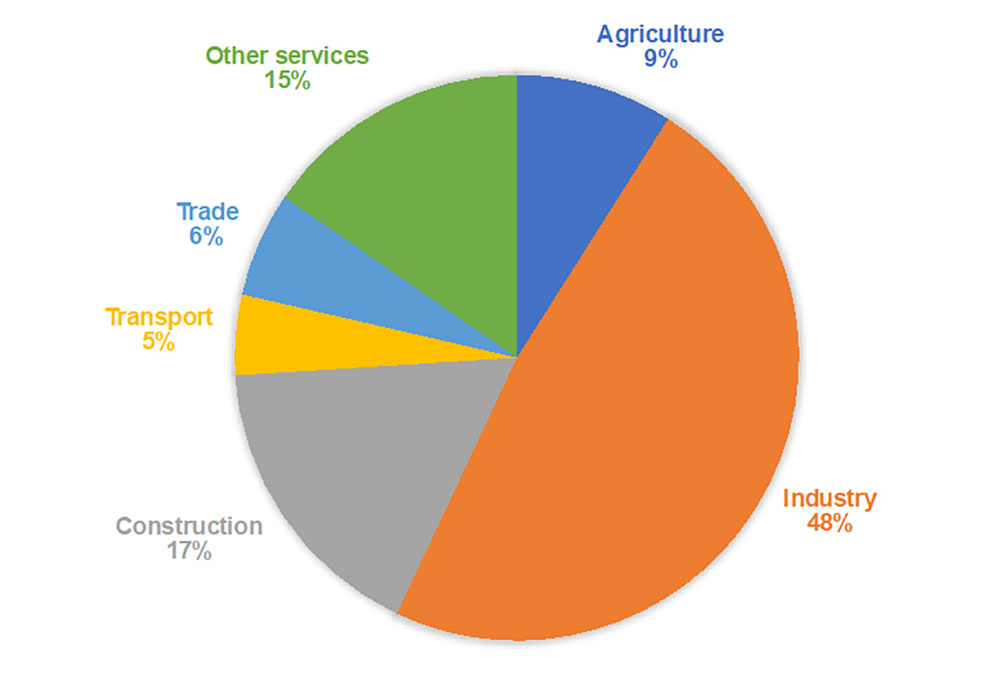What is GDP?
GDP or Gross Domestic Product provides a snapshot of country’s economic performance and the size of its overall economy. It measures the monetary value of all final goods and services (those that are bought by the final user) produced in a country in a given period of time. It is usually calculated on a quarterly and yearly basis (IMF). GDP counts goods such as groceries, smartphones or clothes and services provided by hair dresser, doctor or police. It is one of the most commonly cited figures by government, newspapers, central banks, the business and international community. Policy makers use GDP as a reference point for the health of national economy and proud themselves when GDP is growing. While increase in GDP can signal economic growth, this increase might not always be for a good cause. For example, if after a severe storm or earthquake the country has to rebuild an entire city, these expenses will increase the country’s GDP.
There are two types of GDP, nominal – GDP at current prices, and real – inflation adjusted GDP. Real GDP is important when comparing country’s performance over time. It allows us to see whether the value of output has gone up because more is being produced or simply because prices have increased (IMF).
What is GDP made of?
GDP has four main components:
- Government – goods and services purchased by the government such as education, transportation or military. This spending is financed by taxes and companies or by borrowing money.
- Consumption – goods and services purchased by citizens such as buying food, paying for rent or a haircut. It’s the largest component of GDP.
- Investment – domestic investment and capital expenditures made by firms with the goal of achieving future benefits. For example, a company might purchase a new equipment which will improve its efficiency or build a new factory to expand future production.
- Net exports – the difference between country’s export and import. If the country exports more than it imports, it will experience trade surplus. If the country imports more than it export, then it will run a trade deficit.
Figure 1. GDP and its components
Source: IMF
Figure 1 illustrates how much each of the four components contribute to nominal GDP (at current prices) of Kazakhstan, Uzbekistan and Turkmenistan. Although, the picture for Turkmenistan is incomplete, due to lack of data, we can make some useful inferences. Given that household consumption is generally the biggest component of GDP, which is also the case for Kazakhstan and Uzbekistan, we can assume that it accounts for around half of GDP in Turkmenistan. The figures also show that exports contribute significantly to Turkmenistan’s GDP, which is heavily reliant on the sales of natural resources. For instance, in 2010 the sales of natural gas accounted for 53% and oil for 11% of Turkmenistan’s exports (Djumaev 2012). Similarly, government spending in Turkmenistan contributes 8% to country’s GDP, which is comparable to Kazakhstan. While there is no data on private investment for 2019, in 2020 it added 22-25% to GDP and reached as high as 45-48% in the past years. However, these investments are mainly directed to extracting and processing activities in the oil and gas industries.
What contributes to GDP growth in Turkmenistan?
Since the early days of its independence Turkmenistan’s GDP has heavily relied on the extractive sectors such as oil and gas. In 2014 the sector accounted for almost half of country’s GDP (Figure 2) while employing only 14% of country’s workforce (Figure 3).
Figure 2. Contribution of various sectors to Turkmenistan’s GDP (2014)
Source: The World Bank
Figure 3. Percentage of total employed by sector in Turkmenistan (2012)
In comparison, the agricultural sector only contributed 9% to GDP while employing 46% of the labour force. This implies that the extractives sector in Turkmenistan is capital intensive, requiring large investments while employing only few people. According to the global trends over time, as countries develop, the economic importance of the agricultural sector decreases and the share of the population working in agriculture declines. While economic contribution of the agricultural sector has steadily declined overtime in Turkmenistan, it remains the largest employer in the country. This means that the agricultural sector in Turkmenistan is not efficient as it involves large number of workers but produces small economic output.
Why is GDP important?
GDP is an important measurement of an economy’s size, performance, and general health. It is useful when examining country’s performance overtime to see long-term trends and whether the country is doing better or worse compared to previous years. GDP is also helpful when comparing a country to other countries to see the relative size of its economy and how well it is performing in relation to others.
Likewise, politicians rely on GDP to understand how their policies have impacted the economy and if they have to take any corrective measures. GDP is also commonly used by private companies to plan their expansion into new markets. It shows countries that are growing at the fastest rates and hence might provide the greatest return on their investment.
Donate to support Turkmen analysts, researchers and writers to produce factual, constructive and progressive content in their efforts to educate the public of Turkmenistan.
SUPPORT OUR WORKWhat GDP does not tell us?
While GDP is a useful measurement for market production, it is not a suitable indicator of social progress and well-being of citizens. Even the GDP per capita (the output of goods and services per person), which is often used to show standard of living of an average citizen, fails to capture the things that are important to general well-being. There are several shortcomings of GDP.
First, GDP does not include unpaid work (e.g. household activities, childcare or volunteering) and black-market activities because they are difficult to measure and value accurately (IMF). This means, a service of a babysitter, who gets paid for looking after other people’s children, will count toward GDP but their service of looking after their own child will not count.
Second, GDP growth does not tell us how income is distributed across a population. Rising GDP could result from the richest getting richer, rather than everyone becoming better off.
Third, it does not take into account environmental and social costs associated with producing goods and services. The increased output may come at the cost of environmental damage, depletion of non-renewable natural resources, increased noise, or reduction of leisure time (IMF).
How does GDP affect me?
For politicians, economists and businesses a growing GDP is a sign of a growing economy. This is why governments across the world regularly cite GDP numbers and boasts themselves when the indicator is going up. They equate growing GDP with better economic performance, more job creation, increased salaries and thus better living standards. GDP helps government to decide how much to spend on public services and how much they need to raise in taxes. If GDP is growing steadily, people will be making and spending more money and hence pay more taxes. This means the government will have more money to spend on public services such as schools, police and hospitals. If GDP is shrinking, this means less money for the government and might push them to borrow. For instance, as part of its socio-economic response to global Coronavirus pandemic, Turkmen government plans to borrow USD 700 million from international financial institutions. Hence, country’s GDP can influence how much taxes you pay or what public services you can receive.
Steady GDP growth generally means healthy economy with low unemployment and high salaries as businesses need more labour to meet the needs of the growing economy. Slowing down and decline in GDP can push companies to lay off workers and cut production, which in turn can lead to decrease in business revenues, employment and consumer spending. Therefore, generally speaking, one’s ability to find a job or start a successful business might depend on country’s economic performance. GDP can also tell which sectors of the economy are growing and which are declining. Workers can re-train and acquire necessary skills in those sectors that are growing.
Nevertheless, GDP growth does not automatically result in better living standards for citizens. Government needs to ensure that income generated through economic output is fairly distributed across the population. It also should take into account other indicators such as health, education, employment, leisure and social interactions, economic security, physical safety, governance, basic human rights and natural and living environment as they directly contribute to people’s general well-being.
Do you feel better off when Turkmenistan’s GDP is growing? What other measurements might be useful to assess the quality of life in Turkmenistan?
Sources:
Progres: Resmi we halkara guramalaryň ykdysady görkezijileriniň arasyndaky tapawut
IMF: Gross Domestic Product: An Economy’s All
Harvard Business School: What is GDP and why it is important?
News Central Asia: Международный Инвестиционный Форум – Нефть и Газ
Eurostat: Quality of life indicators – measuring quality of life









